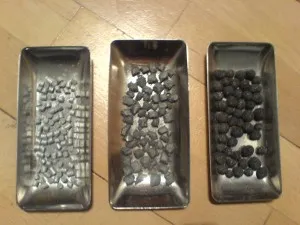5 Things You Didn’t Know About the Science of Fireworks
These iconic symbols of Independence Day celebrations are also a marvel of modern science and engineering
/https://tf-cmsv2-smithsonianmag-media.s3.amazonaws.com/filer/20120704072032ColorfulFireworks-small.png)
Fireworks, a centuries-old technology, are an iconic symbol of Independence Day celebrations—but they’re also a marvel of modern science and engineering. Read on to discover the science behind the fireworks you’ll see all around the country tonight.
1. The chemical formula for fireworks was invented by accident. Sometime during the 10th century, the Chinese began making fireworks with gunpowder (the first-known chemical explosive had only recently been discovered). But scholars believe that the inventors hit upon the chemical formula for gunpowder—sulfur, coal and potassium nitrate, or saltpeter—during attempts to create an elixir of immortality. Over time, the Chinese developed a wide variety of fireworks that produced different types of visual effects, and the pyrotechnician became a respected profession in Chinese society.
2. Fireworks are designed not to explode. Counterintuitively, chemists design fireworks to burn as slowly as possible, rather than explode rapidly. A slower burn means that a firework will produce a visual effect for a longer duration that covers a greater area of the sky. To achieve this, the fuel and oxidizer chemicals used—typically metals such as aluminum or magnesium for fuel, and percholates, chlorates or nitrates for oxidizers—are relatively large-grained, in the range of 250 to 300 microns, about the size of a grain of sand. Additionally, chemists avoid mixing the fuel and oxidizer together thoroughly, making it more difficult for them to burn.

3. Different colors are produced by different chemicals. The bright colors visible when fireworks explode are a result of pyrotechnic stars—pellets of chemicals that generate certain colors or produce sparking effects when burned. When the bursting charge is ignited, the main fuel explodes first, transferring energy to the colorant chemicals, which prompts these chemicals’ electrons to move into an excited state. Then, moments later, when the colorant chemicals cool and the electrons fall back to their base state, they release the extra energy as colorful radiation when they are flying through the sky. The specific color depends on the chemical: compounds with strontium and lithium burn an intense red, while calcium burns orange, sodium burns yellow, barium burns green and copper burns blue.
4. Firework shapes are produced by clever design. To achieve unusually-shaped fireworks, such as double-rings, hearts or stars, technicians pack the fuel and colorant chemicals inside a tube in different formations. A central core of fuel, surrounded by a ring of pellets, will produce a circular firework, while a double-layer of pellets will create a double-ring in the sky. If the pellets are mixed together in the inside with the fuel, the streaks of color will spread out together from a central point, as in the “willow tree” pattern. For especially tricky formations, such as a heart or star, the colorant pellets are glued to a piece of paper in a the desired shape. When the fuel burns, it ignites the paper, sending the colorants flying in the same pattern.
5. Fireworks pollute. Despite all the fun of firework shows, they do have a downside. We’ve previously written about how pyrotechnics can startle and even kill bird populations. They can also harm wildlife in a more insidious way—by introducing heavy metals, sulfur-coal compounds and percholate into local bodies of water. Fireworks are often launched over lakes and rivers, and these byproducts of combustion can may harm aquatic ecosystems over time. Airborne pollutants can also affect humans, especially those suffering from asthma.
/https://tf-cmsv2-smithsonianmag-media.s3.amazonaws.com/accounts/headshot/joseph-stromberg-240.jpg)
/https://tf-cmsv2-smithsonianmag-media.s3.amazonaws.com/accounts/headshot/joseph-stromberg-240.jpg)